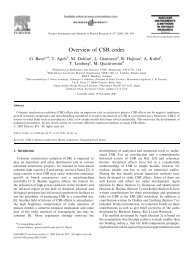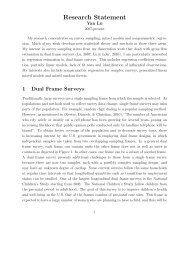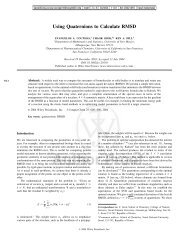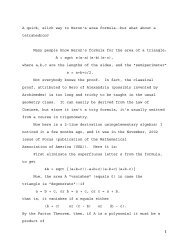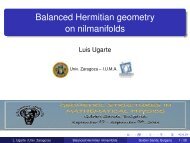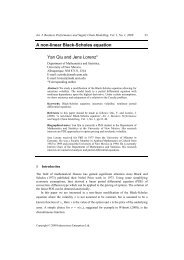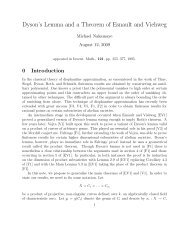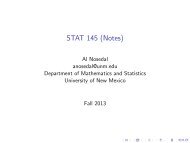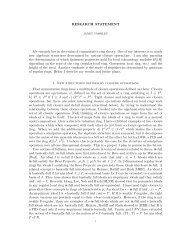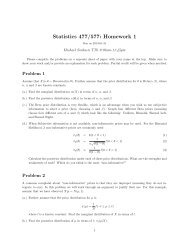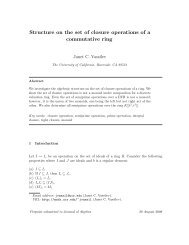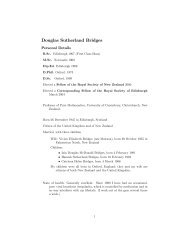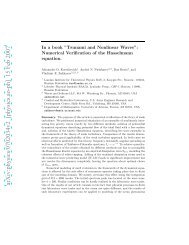OEO Office of Equal Opportunity - Department of Mathematics and ...
OEO Office of Equal Opportunity - Department of Mathematics and ...
OEO Office of Equal Opportunity - Department of Mathematics and ...
You also want an ePaper? Increase the reach of your titles
YUMPU automatically turns print PDFs into web optimized ePapers that Google loves.
148 ARTS AND SCIENCES<br />
504./304. Current Research in Anthropology. (1-3)<br />
This course familiarizes students with current, active research<br />
in Anthropology by the University <strong>of</strong> New Mexico faculty <strong>and</strong><br />
visiting scholars. It also teaches students to critically assess<br />
<strong>and</strong> discuss research questions. (A, B, E, HEE)<br />
509. Seminar in Native American Art. (3, no limit) ∆<br />
Szabo<br />
(Also <strong>of</strong>fered as ARTH 559.)<br />
Restriction: permission <strong>of</strong> instructor. (E)<br />
Prerequisites: 501 <strong>and</strong> 503. {Offered upon dem<strong>and</strong>}<br />
510./410. Topics in Linguistic Anthropology. (3 to a<br />
maximum <strong>of</strong> 15) ∆<br />
Topics from various areas <strong>of</strong> anthropological linguistics<br />
including, but not limited to, ethnosemantics, the ethnography<br />
<strong>of</strong> communication <strong>and</strong> the biology <strong>of</strong> language. (E)<br />
511./310. Language <strong>and</strong> Culture. (3)<br />
(Also <strong>of</strong>fered as CJ 519 <strong>and</strong> LING 559.) Examination <strong>of</strong> the<br />
interrelations <strong>of</strong> language <strong>and</strong> speech with other selected<br />
aspects <strong>of</strong> culture <strong>and</strong> cognition.<br />
Prerequisites: 110 or LING 101 or LING 292. (E) {Spring}<br />
512./413. Linguistic Field Methods. (3) Gorbet<br />
(Also <strong>of</strong>fered as LING 513.) Practice in transcribing from<br />
oral dictation, phonemic analysis, introduction to problems<br />
<strong>of</strong> morphology.<br />
Prerequisites: 317. Restriction: permission <strong>of</strong> instructor. (E)<br />
{Offered upon dem<strong>and</strong>}<br />
513. Functional Syntax. (3)<br />
(Also <strong>of</strong>fered as LING 523.) Description <strong>and</strong> explanation <strong>of</strong><br />
morphological, syntactic <strong>and</strong> discourse phenomena, both in<br />
language-specific <strong>and</strong> topological perspective, in terms <strong>of</strong><br />
their cognitive representations <strong>and</strong> the cognitive <strong>and</strong> interactional<br />
processes in which they function.<br />
Prerequisite: LING 322. (E)<br />
514. Seminar: Linguistic Theory. (3)<br />
(Also <strong>of</strong>fered as LING 554.) Current topics <strong>and</strong> issues in<br />
phonology, syntax or semantics. (E)<br />
515./415. Native American Languages. (3)<br />
(Also <strong>of</strong>fered as LING 515.) Survey <strong>of</strong> Indian languages <strong>of</strong><br />
North America, with special emphasis on languages <strong>of</strong> New<br />
Mexico. Topics: linguistic structure in particular languages<br />
<strong>and</strong> language families; relationship <strong>of</strong> languages <strong>and</strong> cultures;<br />
<strong>and</strong> language loss, maintenance <strong>and</strong> preservation. (E)<br />
516./416. Introduction to Language Change. (3)<br />
(Also <strong>of</strong>fered as LING 546.) Theories <strong>and</strong> methods <strong>of</strong> comparative<br />
<strong>and</strong> historical linguistics, emphasizing change in<br />
English, Indo-European <strong>and</strong> Native American languages.<br />
Prerequisite: 317. (E) {Alternate years}<br />
517./317. Phonological Analysis. (3) Gorbet<br />
(Also <strong>of</strong>fered as LING 504.) Phonetic principles <strong>and</strong> phonological<br />
theory, descriptive analysis <strong>of</strong> phonological systems,<br />
transcriptional practice <strong>and</strong> problems from selected<br />
languages.<br />
Prerequisite: LING 303. (E) {Fall}<br />
520./320. Strategy <strong>of</strong> Archaeology. (3) Boone,<br />
Ramen<strong>of</strong>sky<br />
The purpose <strong>and</strong> theory <strong>of</strong> the study <strong>of</strong> archaeology; relates<br />
archaeology to anthropological principles <strong>and</strong> the practice<br />
<strong>of</strong> science.<br />
Prerequisites: 101 <strong>and</strong> either 121L or 220. (A) {Yearly}<br />
521./321. Southwest Archaeology. (3) Wills, Crown,<br />
Chapman<br />
An intensive survey <strong>of</strong> Southwest prehistory including discussion<br />
<strong>of</strong> major interpretative problems. Covers the period from<br />
11,000 years ago to historic times. (A) {Fall}<br />
522./322. Mesoamerican Prehistory. (3) Santley<br />
An advanced survey <strong>of</strong> the prehistory <strong>of</strong> Mexico, Guatemala<br />
<strong>and</strong> Belize from the origins <strong>of</strong> village farming to the Spanish<br />
conquest. (A)<br />
523./323. Archaeology <strong>of</strong> Eastern North America. (3)<br />
Ramen<strong>of</strong>sky<br />
A survey <strong>of</strong> the archaeology <strong>of</strong> Eastern North America that<br />
begins with human entry into the East <strong>and</strong> terminates with<br />
European discovery <strong>and</strong> settlement. (A) {Alternate years}<br />
524./324. American Archaeology: South America. (3)<br />
Archaeology <strong>of</strong> South America from the Paleo-Indian to the<br />
European period. Emphasizes the origins <strong>and</strong> evolution <strong>of</strong><br />
Andean civilization <strong>and</strong> associated interpretive problems. (A)<br />
{Alternate years}<br />
525./325. Stone Age Europe. (3) Straus<br />
The prehistory <strong>of</strong> Europe with emphasis on hunter-gatherer<br />
adaptations <strong>of</strong> the Pleistocene <strong>and</strong> early Holocene using<br />
primary data sources.<br />
Prerequisites: 101 <strong>and</strong> 220. (A) {Alternate years}<br />
526./326. Late European Prehistory. (3) Boone<br />
An intensive survey <strong>of</strong> the later prehistory <strong>of</strong> Europe, from the<br />
development <strong>of</strong> agricultural communities through the Roman<br />
Empire. (A) {Alternate years}<br />
527./327. African Prehistory. (3) Straus<br />
The prehistory <strong>of</strong> Africa from the appearance <strong>of</strong> the first hominids<br />
to the development <strong>of</strong> complex societies.<br />
Prerequisites: 101 <strong>and</strong> 220. (A) {Alternate years}<br />
528./328. Near Eastern Archaeology. (3) Boone<br />
A survey <strong>of</strong> the Near Eastern culture area from the origins <strong>of</strong><br />
agriculture to the development <strong>of</strong> Bronze Age civilization. (A)<br />
{Offered periodically}<br />
529./329. Archaeology <strong>of</strong> Complex Societies. (3) Boone,<br />
Santley<br />
Comparative approach to origin <strong>and</strong> development <strong>of</strong> stratified<br />
societies <strong>and</strong> pristine states as known from the archaeological<br />
record. (A)<br />
530. Topics in Ethnology. (3, no limit) ∆<br />
Current topics in ethnology to be explored in experimental<br />
seminars. (E)<br />
531./331. Indigenous Peoples <strong>of</strong> North America. (3)<br />
Major culture types <strong>and</strong> selected ethnographic examples <strong>of</strong><br />
North American Indian cultures. (E) {Offered annually}<br />
532./332. Indigenous Peoples <strong>of</strong> South America. (3)<br />
Culture <strong>and</strong> history <strong>of</strong> indigenous peoples <strong>of</strong> South America.<br />
Selected examples from lowl<strong>and</strong> <strong>and</strong> highl<strong>and</strong>s regions. (E)<br />
{Offered periodically}<br />
533./333. Ritual Symbols <strong>and</strong> Behavior. (3)<br />
(Also <strong>of</strong>fered as RELG 533.) Comparative analysis <strong>of</strong> ritual<br />
processes, symbolic systems <strong>and</strong> world views in the context<br />
<strong>of</strong> social structure. (E) {Offered annually}<br />
534./330. Principles <strong>of</strong> Cultural Anthropology. (3)<br />
Development <strong>of</strong> ideas <strong>and</strong> theories in sociocultural anthropology;<br />
focus on topics such as integration <strong>of</strong> human societies,<br />
sources <strong>of</strong> change in economic <strong>and</strong> cultural systems. (E)<br />
535./345. Spanish-Speaking Peoples <strong>of</strong> the Southwest. (3)<br />
Analysis <strong>of</strong> the ethnohistory <strong>and</strong> modern culture patterns <strong>of</strong><br />
Spanish-speaking peoples <strong>of</strong> the Southwest. (E) {Alternate<br />
years}<br />
536. Theories <strong>of</strong> Symbolic Action. (3)<br />
An examination <strong>and</strong> application <strong>of</strong> various modern theories<br />
<strong>of</strong> symbolic analysis. Readings include Levi-Strauss, Geertz,<br />
Douglas, Turner <strong>and</strong> Leach.<br />
537. Seminar: Southwestern Ethnology. (3)<br />
Examination <strong>of</strong> data <strong>and</strong> theories relevant to study <strong>of</strong> Indian,<br />
Hispanic <strong>and</strong> dominant society cultures in southwestern U.S.<br />
<strong>and</strong> northwestern Mexico. Student research generated from<br />
students pr<strong>of</strong>essional interests. Non-majors admitted. (E)<br />
539./339. Human Rights in Anthropology. (3)<br />
A description <strong>and</strong> analysis <strong>of</strong> competing theories about the<br />
content <strong>of</strong> human rights; the history, politics <strong>and</strong> economics<br />
UNM CATALOG 2006–2007 Symbols, page 611.



